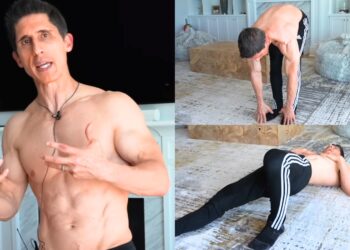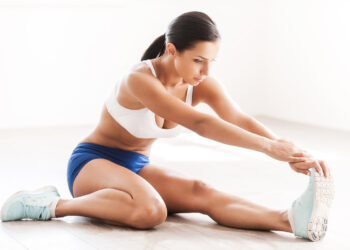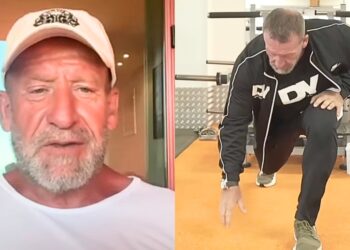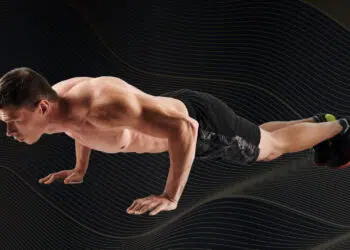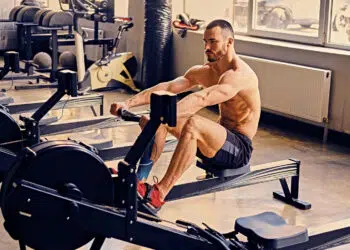Whatever your training goal, you need to train your legs. Bodybuilders look RIDICULOUS when their upper bodies are more developed than their legs. Athletes from all sports need leg strength and power to run and jump effectively.
Want to lose fat and get lean? Guess what – leg training will help. After all, moving your legs requires a lot of energy, and the more energy you use, the faster you’ll lose weight. It’s no coincidence that virtually every fat-burning exercise involves your legs.
However, you can’t just do endless sets of lunges, leg presses, and squats for your lower body. Instead, you need to stretch your muscles, too.
Stretching helps reduce the tightness that could otherwise limit mobility and flexibility. Tight muscles are also more prone to injury and can even affect the health of your joints.
In this article, we reveal the seven best quadriceps stretches. Stretching your quads regularly will help keep your knees healthy and mobile.
Quadriceps Anatomy 101
While you don’t need a degree in functional anatomy to stretch your quadriceps muscles or quads for short, it may be helpful to know a little more about this powerful muscle so you can choose the best exercises.
Level Up Your Fitness: Join our 💪 strong community in Fitness Volt Newsletter. Get daily inspiration, expert-backed workouts, nutrition tips, the latest in strength sports, and the support you need to reach your goals. Subscribe for free!
The term quadriceps refers to the fact that this body part is actually made up of four individual muscles. The four quadriceps have separate origins or starting points and come together at a single insertion point called the quadriceps tendon.
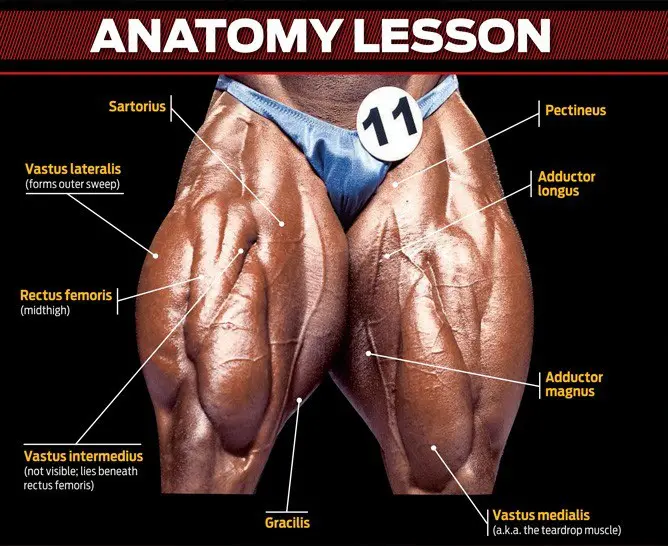
The four quadriceps are:
Rectus femoris
The rectus femoris is the longest of the quadriceps muscles. It’s also biaxial, meaning it crosses two joints. As such, the rectus femoris has two primary functions: knee extension and hip flexion. Because of this, some quads stretches also affect the hip flexors. Doing these stretches will ensure that rectus femoris gets the attention it deserves.
Vastus medialis
Where rectus femoris is the longest quadriceps muscle, vastus medialis is the shortest. This muscle is just above your knee and shaped like a teardrop. It’s responsible for straightening the knee and is most active in the last few degrees of extension.
The vastus medialis plays a critical role in knee stability and helps prevent unwanted lateral movements.
A tight vastus medialis can cause the patella to move out of alignment, which can cause joint problems. The most common form of this condition is called patellofemoral knee pain. Stretching the vastus medialis, and quads in general, may help prevent future knee joint issues.
Vastus intermedius
Located between vastus medialis and vastus lateralis, this long muscle really stands out at the front of your thighs. It’s a very powerful knee extensor and makes up much of the bulk of your anterior thighs.
Vastus lateralis
The vastus lateralis is the largest, strongest muscle in the quadriceps group. It’s located on the side of your thigh and gives your quads their width. Well-developed vastus lateralis gives your thighs a pleasing shape, which is often called the quad sweep.
As well as being a knee extensor, the vastus lateralis also plays a vital role in knee joint stability, especially during walking, running, and other unilateral or single-legged exercises.
7 Best Quadriceps Stretches
Now you know what the quadriceps do and where they’re located, it’s time to move into stretching this powerful muscle group. The best quads stretches are outlined below, but you don’t need to do all of them. Instead, just pick 1-2 and do them daily. Feel free to rotate exercises from time to time for the sake of variety.
Take care not to stretch your quadriceps too aggressively, as doing so could cause knee pain. Instead, stretch to a point where you feel mild tension in your quads but not in your joints. Do not force yourself into a deeper stretch.
1. Standing quadriceps stretch
This simple exercise is ideal for when you want a quick quads stretch that you can do without equipment or having to lie down, e.g., before you go for a run. Because it’s so straightforward, this is the ideal exercise if you want to stretch your quads several times a day. In fact, you could get up and do it right now!
How to do it:
- Stand with your feet together and arms by your sides. Adopt a good, upright posture. Bend your knees slightly for balance.
- Shift your weight over onto one foot and then bend your leg behind you. Reach back and grip the top of your ankle with one or both hands. Keep your shoulders down and back, and look straight ahead.
- Gently pull your foot toward your butt to lengthen and stretch your quads. Keep your thighs together throughout.
- Hold for 20-60 seconds, increasing the stretch as you feel your muscles relax and lengthen.
- Lower your foot to the floor, swap legs, and repeat.
Pro tips: Get a deeper quads stretch by pushing your hips forward. This hits the rectus femoris a little more. Lean against a wall if you find it difficult to maintain your balance.
2. Prone quadriceps stretch
Stretching your quads while standing is convenient, but it’s probably not the best exercise if you want to do a prolonged stretch, e.g., 60 seconds or more. That’s where this stretch comes in! The prone quads stretch is very comfortable and ensures that your hips and knees are correctly aligned.
Level Up Your Fitness: Join our 💪 strong community in Fitness Volt Newsletter. Get daily inspiration, expert-backed workouts, nutrition tips, the latest in strength sports, and the support you need to reach your goals. Subscribe for free!
How to do it:
- Lie flat on the floor with your legs straight and your head resting on your folded arms.
- Bend your left leg, reach back with your left arm, and hold your ankle.
- Gently pull your foot toward your butt, taking care not to lift your shoulders or twist your back. Your thigh should remain in contact with the floor.
- Remain in position for 20-60 seconds or more, increasing the stretch as you feel your muscles relax and lengthen.
- Release your foot, swap sides, and repeat.
Pro tip: If you find it hard to reach your foot without straining, use a yoga strap to “lengthen” your arms. Loop the strap over your foot and then grip it, so you don’t have to reach back so far.
3. Side-lying quadriceps stretch
Lying on your front can be uncomfortable for some people, especially if you are overweight, pregnant, or have a sore lower back. Some people may find this side-lying quad stretch more accessible. As an added advantage, you will still be able to see what’s happening around you.
How to do it:
- Lie on your side with your hips stacked, shoulders square, and legs together. Rest your head on your outstretched arm.
- Bend your uppermost leg and reach back to grab your ankle.
- Gently pull your foot into your butt.
- Remain in position for 20-60 seconds or more, increasing the stretch as you feel your muscles relax and lengthen.
- Release your foot, roll over, swap sides, and repeat.
Pro-tip: Increase the stretch by pushing your top hip forward slightly. This puts more emphasis on the rectus femoris muscle.
4. Half-kneeling quads stretch
Most quads stretches are done with the knees together. While this is good for joint health, it’s not so good for hitting the rectus femoris. The half-kneeling quads stretch extends your hip, so the rectus femoris is lengthened and gets a more intense stretch. However, this is a more demanding exercise and may be difficult if you have poor flexibility.
How to do it:
- Adopt a half-kneeling position with one foot flat on the floor in front of you and your opposite knee roughly two feet behind.
- Bend your rear leg, grasp your ankle, and pull your foot into your butt. Keep your torso upright, do not twist your hips or shoulders, and do not hyperextend your lumbar spine.
- Remain in position for 20-60 seconds or more, increasing the stretch as you feel your muscles relax and lengthen.
- Release your foot, swap sides, and repeat.
Pro tips: For comfort, place your knee on a folded towel or use a foam pad. If you find it hard to reach your foot without straining, use a yoga strap to “lengthen” your arms. Loop the strap over your foot and then grip the strap, so you don’t have to reach back so far.
5. Couch stretch
The couch stretch is a slightly more comfortable version of the half-kneeling quads stretch. With this exercise, you place your foot on a couch, bench, or low chair, so you don’t have to reach back and hold your ankle. You can also press your hips backward to create a deeper stretch. Of course, you will need a couch to do this exercise, so it may not always be practical.
How to do it:
- Adopt a half-kneeling position in front of a low couch. Bend one leg and place the top of your foot on the seat behind you.
- Keeping your torso upright, shuffle backward and push your butt toward your foot.
- Remain in position for 20-60 seconds or more, increasing the stretch as you feel your muscles relax and lengthen.
- Release your foot, swap sides, and repeat.
Pro tip: Make this stretch more intense by placing your rearmost foot against a wall. This will result in a much deeper stretch, not only for your quads and hips but your ankle, too.
6. Heel sitting quads stretch
Sitting on your heels used to be a resting and working position before chairs were invented. While some cultures still do a lot of heel sitting, most people in the western world have lost the ability to perform this basic movement. That’s a shame because heel sitting is a great way to stretch your quads and mobilize your knees.
How to do it:
- Kneel down so your knees are about hip-width apart and your lower legs are roughly parallel.
- Ease your hips back and rest your hamstrings on your calves.
- Relax and allow your butt to sink down to your heels.
- Keep your torso upright, and your upper body relaxed throughout.
- Remain in position for 20-60 seconds or more, increasing the stretch as you feel your muscles relax and lengthen.
- If you find sitting on your heels uncomfortable, place a yoga block or folded pillow behind you and sit on that. This will save you from having to stretch so deeply. Remove the block once you become more accustomed to heel sitting.
Pro tips: Increase your range of motion by placing yoga blocks or a rolled exercise mat under your feet. You can also get a deeper stretch by leaning your torso backward, supporting your weight by placing your hands on the floor just behind your feet.
You can also do this exercise with one leg at a time:
7. Foam rolling the quadriceps
Your muscles are surrounded by a thin layer of fibrous tissue called fascia. Fascia separates and connects each muscle from its neighbor. This fascia can become “gummed up,” leading to tight, painful muscles. This can cause trigger points, poor blood flow, and reduced function.
Foam rolling is a form of self-massage called self-myofascial release that can help free up your fascia and restore normal movement and function. Foam rolling your quads will enhance knee and hip joint mobility and performance.
How to do it:
- Lie on your front on your foam roller. The roller should be under your thighs. Shift your weight across to emphasize one leg at a time. Bend the knee on the leg you want to work on.
- Roll back and forth along your thigh, turning your leg in and out to hit all four of your quads.
- Seek out any areas of tightness and spend a little longer working on them until they start to diminish.
- Increase the pressure by crossing your other leg over the one you’re treating.
- Continue for 2-4 minutes, and then swap sides.
Pro tip: Foam rolling can be painful. But, as the adhesions start to dissolve, subsequent foam rolling sessions should be less uncomfortable. Increase the pressure gradually to avoid unnecessary pain.
More Stretches:
- Don’t Just Sit There! 8 Useful Things to Do Between Sets in The Gym
- Essential 6-Minute Stretching Sequence for Immediate Muscle Relief
- Partner-Assisted Stretching: Just Lazy or the Key to Optimizing Your Flexibility?
- Age-Proof Your Body: The Ultimate Guide to Exercises That Prevent Mobility and Muscle Loss
- Unlock Your Hip Flexors: Assisted Prone Lying Quads Stretch Guide
- 10 Best Abs Stretches to Improve Flexibility
- Say Goodbye to Stretching: Relieve Upper Body Tension with This 10-Minute Foam Rolling Routine
- How a 2-Minute Hanging Habit Transforms Your Body (Science Explained)
Quadriceps Stretches – Wrapping Up
While it’s true that you should never skip leg day, it’s not enough just to build and strengthen your quads. You need to stretch them too. Flexible quads will enhance knee health and allow you to squat and lunge more deeply, making these exercises even more effective.
If you can’t comfortably pull your feet into your butt, it’s a safe bet that your quads are too tight. Fix this issue before it starts to cause knee problems by doing 1-2 of these quads stretches daily.
Better still, stretch your quads several times a day to restore lost flexibility sooner.


